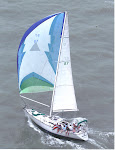“If
you can not fix the head, you can't go to sea.” is an old saying
with a lot of truth. The head is so important that usually the
captain is in charge of maintenance on most small yachts. White
Pepper has her share of horror
stories about broken potties, plugged up hoses, frozen Y-valves, and
botched pump-outs as does every yacht.
I
have replaced (once) and rebuilt (twice) White Pepper's
venerable Skipper Mate potty from Wilcox Crittenton for so long that
parts are no longer available for this model. Last year I had come to
dread using the head wondering every day whether this would be the
time when the lever would not move (or worse spin freely.) That
moment came on Mother's Day 2014. The potty broke. Fortunately, that
was the last day Jan and I were on the water. Haul out was scheduled
for the next day. Here was the time to take a different direction.
We
had seen a composting head at the Annapolis Boat Show in 2012 and
were intrigued. A
composting head has no moving parts except for a rotating handle and
simply can not break.
The difference between a composting head and a porta-potty or bucket
is that the urine and solid waste are separated. The separation is
accomplished by some clever but simple mechanical engineering. The
urine compartment has to be emptied every day or every other day.
The solid waste is mixed with peat moss or shredded coconut husk and
allowed to compost. The composting process begins immediately but
takes several months to complete. The bucket has to be emptied
somewhere around 3 or 4 weeks with regular use by two people. A
vent and fan keep the odor to practically zero.
Jan
and I had three choices. The Air Head was the first on the market
and claims to be the best. Nature's Head is slightly larger and
claims to be even better. It does have a larger seat and is a closer
fit to the traditional potty. The C-Head is about 1/3 cheaper. It
probably works perfectly fine, but we did not believe it was study
enough for long term sea duty. Eventually we chose the Air Head as
it fit better in the head compartment. The seat is, however, small.
The Air Head is made of quality materials, is well designed, and
seems likely to last.
The
Air Head arrived at Green Cove Springs Marina. There is nothing
complicated about the installation. Possibly the only tricky part
was drilling a 3 and 3/8” hole in the cabin top for a vent.
However, I wimped out and let the yard install the head. Part of the
reason I did so was that I wanted the through hull fitting removed
and glassed over. I did take out the old potty, holding tank and
hoses myself. All of this material along with the large through hull
fitting probably weighed 150 pounds. Also I had two hose exits at
the waterline glassed over. One was for the holding tank vent and
the other was for a long extinct head sump pump hose. A benefit of
this effort was that a leak over the stove 10 feet away stopped. Jan
repainted the cabinets. Fiberglasser Charlie did a great job on the
holes and modified the head compartment to accommodate the head.
Technician Bobby mounted a vent and fan. I had to buy a cowl vent
hood with a Dorade mechanism.
Jan
put in a load of premium shredded coconut husks and kicked on the new
era last month. I have delayed this post until after emptying the
solid waste compartment today. Dumping the urine bottle is no problem
and by the way is completely legal. All of the laws are written to
control solid waste and E. coli contamination. Urine is sterile and
is legal to dump. The solid waste is another matter and is supposed
to be deposited in special sites. The Air Head company says that
after 3 months the material is completely composted can be spread
under non food plants. But the bucket needs to be changed about every
month. Today White Pepper
sailed out of the Fort Pierce Inlet to 3 miles offshore and dumped
the honey bucket. Frankly the “yuk” factor was no worse than
changing a baby's diaper—not pleasant, but not terrible. Most of
the solid waste was just moldy dirt although some of today's deposit
was still obviously feces.
I
wore disposable gloves and cleaned up with vinegar. Strong chemicals
are forbidden as they halt the composting process. More coconut husk
was added and the whole process didn't last 10 minutes.
We
are very pleased with the composting head. My take is that you make
a choice as to where you place the effort. We would rather make the
effort to empty the pee bottle and honey bucket more often, rather
than struggle with the hoses, valves, holding tank and intricacies of
a traditional potty.





